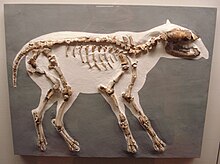This article needs additional citations for verification. (July 2023) |
| Palaeotheriidae | |
|---|---|

| |
| Palaeotherium magnum skeleton | |

| |
| Fossil of Plagiolophus | |
| Scientific classification | |
| Domain: | Eukaryota |
| Kingdom: | Animalia |
| Phylum: | Chordata |
| Class: | Mammalia |
| Order: | Perissodactyla |
| Superfamily: | Equoidea |
| Family: | †Palaeotheriidae Bonaparte, 1850 |
| Genera | |
| |
| Synonyms | |
|
Pachynolophidae Pavlow, 1888 | |
Palaeotheriidae is an extinct family of herbivorous perissodactyl mammals that inhabited Europe, with less abundant remains also known from Asia,[3] from the mid-Eocene to the early Oligocene. They are classified in Equoidea, along with the living family Equidae (which includes zebras, horses and asses).[4]
- ^ Remy, Jean A.; Krasovec, Gabriel; Marandat, Bernard (2016). "A new species of Propalaeotherium (Palaeotheriidae, Perissodactyla, Mammalia) from the Middle Eocene locality of Aumelas (Hérault, France)". Palaeovertebrata. 40 (2): e1. doi:10.18563/pv.40.2.e1.
- ^ Perales-Gogenola, L.; Badiola, A.; Gómez-Olivencia, A.; Pereda-Suberbiola, X. (2023). "A remarkable new paleotheriid (Mammalia) in the endemic Iberian Eocene perissodactyl fauna". Journal of Vertebrate Paleontology. 42 (4): e2189447. doi:10.1080/02724634.2023.2189447. S2CID 258663753.
- ^ Bai, Bin (November 2017). Hautier, Lionel (ed.). "Eocene Pachynolophinae (Perissodactyla, Palaeotheriidae) from China, and their palaeobiogeographical implications". Palaeontology. 60 (6): 837–852. Bibcode:2017Palgy..60..837B. doi:10.1111/pala.12319. ISSN 0031-0239.
- ^ Perales-Gogenola, Leire; Badiola, Ainara; Gómez-Olivencia, Asier; Pereda-Suberbiola, Xabier (2021-01-02). "New Leptolophus (Palaeotheriidae) species from the Iberian Peninsula and early evidence of hypsodonty in an Eocene perissodactyl". Journal of Vertebrate Paleontology. 41 (1). Bibcode:2021JVPal..41E2061P. doi:10.1080/02724634.2021.1912061. ISSN 0272-4634.